Christopher Ian Thoma's Blog, page 3
July 19, 2024
Review – Tamdhu, 15 Years Old, 46%

Aristotle once summarized art’s aim. He noted that art’s essential goal is “to represent not the outward appearance of things, but their inward significance.” In other words, art interprets essence. It is its conduit. The materials and method comprise the vernacular. Skill arranges them. In the process, life’s invisibles become visible.
In this regard, Michelangelo could say, “I saw the angel in the marble and carved until I set him free.” Similarly, Rodin could reply, “I invent nothing. I rediscover.”
Not everyone can do this. Some can, but probably shouldn’t.
For example, I used to visit Russia. I speak very little Russian, and therefore, I require an interpreter. Understandably, the process is a nuanced one. An English sentence might need two in Russian and vice versa. However, when teaching, one-to-one literal interpretation is often preferable. Once, while teaching, I spoke several sentences before pausing to allow the interpreter to convert the concept. Saying nothing, she motioned for me to continue. I did, assuming she wanted a few more of the concept’s details before interpreting. I spoke a few more sentences before pausing again. She motioned again. I kept going. This back-and-forth lasted two or three minutes before I finally insisted that she interpret what had been said. She offered a single sentence and then nodded for me to proceed. When it came time to test the students’ understanding, the concept’s essence was, as expected, blurry.
In the art world, this is Salvadore Dalí.

I and my family visited the Dalí Museum in St. Petersburg, Florida. Dalí is a Spanish painter best known for his bizarre surrealism. Having come face to face with many of his originals, I left the gallery glad that I’d seen them, ultimately admitting he was a man of great skill. Indeed, many of his pieces are extraordinary, proving a talent unavailable to most. His largest portrait, the 14 feet tall and nine feet wide “The Discovery of America by Christopher Columbus,” is absolutely astounding, rivaling some of history’s greats. Some of his smaller oil-on-canvas and burlap portraits are just as moving, if not breathtaking. His sculptures and jewelry designs are crisply enticing, too.
But I also left the gallery feeling as though Dalí was somewhat of a pretentious hack. The child of a well-to-do family in early twentieth-century Catalonia, I deduced him more the stereotypical rich kid from the 80s movies who demanded luxury and did what he wanted with other people’s things. For example, I learned that when visited by his friend and poet, Paul Éluard, he coveted Éluard’s wife, Gala. Eventually, she became his wife. What’s more, his infamous floral and fruit pieces are nothing more than prints from skilled but unknown artists he randomly graffitied. The originals were quite exquisitely done, that is, until Dalí discovered them and, in his boredom, decided to spice them up with child-like doodles that more than subtract from their beauty.
Schumann once scribbled, “To send light into the darkness of men’s hearts—such is the duty of the artist.” I know this may be offensive to the art weirdos out there, but with surrealistic portraits like “The Great Maturbator” and others exploring necrophilia, the best description I have for Dalí after leaving his gallery and learning about his life is that he had skill and means, but he lacked the human soul’s language. Taking mushrooms and then painting what you experienced is not a soulful revelation or a representation of inward significance. It’s a fever dream’s nonsense pitched toward human darkness. Perhaps worse, taking someone else’s work and drawing over it is by no means carrying forth on the shoulders of giants. It’s sitting on the giant’s shoulders and urinating. Again, Dalí seemed a little like a teenage rich kid in an 80s movie who drives and crashes his dad’s car without care or concern.
There are Dalí-like distilleries. I can think of a few. But then there are the incorruptible masters, the ones that understand whisky-making, much like art, as an opportunity to send light into darkness. They are precise with their materials and method, whispering alongside Van Gogh, who mused, “Great things are done by a series of small things brought together.”
Tamdhu is such a distillery, and its 15-year-old edition is one of its finer compilations.
The nose paints a colorful landscape of apple and plum trees coated by a cinnamon winter. The palate sees playful children carting chocolate-coated oak baskets filled with spiced red berries from another unseen orchard. The finish, pleasantly long, shows others roasting the berries, cinnamon apples, and plums, with the apples being the most preferred by the smiling characters.
If the Tamdhu 15-year-old edition were a painting, I’d hang it on my wall and drink in its interpretive grandeur daily. Although, I must admit I’m glad it isn’t in a frame on my wall but in a bottle on my shelf. In this form, it can be art’s reality of opportunity, once described by Theodore Dreiser as “the stored honey of the human soul.”
Indeed, it is that good.
The post Review – Tamdhu, 15 Years Old, 46% appeared first on AngelsPortion.
July 18, 2024
Review – Grangestone, Sherry Cask Finish, (No Age Stated), 40%

The sign in the restaurant’s window was relatively large. No passerby would miss it. What’s more, it was apparent that its creator took a lot of time and offered great care in its design. It was meant to be seen, read, and understood. Its bolded one-word title and font were grand by comparison to its simpler three-word subtext beneath, and its varying colors confirmed its thoughtful formation.
Still, I did not understand its message. The restaurant’s doors were locked. Hands cupped around my eyes, I peered through the front windows. It was a dim and motionless space. But again, why? I looked back to the window’s sign. I studied its meticulously crafted message, hoping for something, a clue, I may have missed. And yet, bafflement remained.
What does “COLESED” mean, and why will the establishment remain in this mysterious condition until further notice? I searched for an explanation.
Certainly, the message’s creator didn’t mean “closed.” What’s printed is too gross a misspelling for this to mean “closed.” Besides, with such a carefully crafted sign, likely viewed by more than its creator, it seems impossible for such a glaring error to have been overlooked, even by a manager. With that, as Sir Arthur Conan Doyle spoke through the character Sherlock Holmes, “When you have eliminated the impossible, whatever is left, however improbable, must be the truth.”
Perhaps “colesed” is a precision term used among restauranteurs. In other words, as we, the everyday patrons, might simply say someone experienced food poisoning by eating some bad coleslaw, a proprietor might record the unfortunate incident as a “colesing,” or in another way, someone was “colesed.” In the case of cottage cheese poisoning, they would report the person was “cottaged.” Such precision might assist the Health Department with its investigation, thereby speeding the re-opening process along.
But how would this apply in this instance? The message’s structure assumes an ongoing condition of colesed until a decision is made to be uncolesed. Could the message mean something else?
Could it be that the Australian supermarket chain “Coles” acquired the restaurant in a corporate takeover? Or maybe Coles has merely assumed indefinite management of this small restaurant for another reason. Either way, it could thereby be labeled “Colesed.” That would make more sense. Although, this was a restaurant and not a supermarket.
I looked at my daughter beside me and asked, “What does this sign mean?” She gave no reply. Therefore, because the lights were off and all was tightly locked, we assumed a knock at the door would do very little. We left for another establishment.
Later that day, still troubled by the enigmatic message, I reached for something that spoke in delightfully uncomplicated ways: the sherry cask-finished edition from Grangestone.
For many whiskies, the tasting notes provided on any given canister or label are most often deemed a subjective suggestion by those with reasonable senses. Relative to this edition, this is not true. Everything an imbiber needs to know is clearly communicated—no careless scripting resulting in misspellings, poor punctuation, or secretive terms leading to misused grammatical designations. The distiller tells you what to expect.
The nose offers vegetal scents and dried oak. This is true. The palate is a pleasant wash of spice, caramel, and premium sherry grapes. This is true, too. The finish is a medium drag of the palate’s spice. Again, this is true.
I’ll keep an eye on the restaurant I mentioned. If it reopens, I’ll at least pop in for a quick clarification and then report back. Doing so is certainly akin to my need for information—and the need to experience my family’s blushing embarrassment.
The post Review – Grangestone, Sherry Cask Finish, (No Age Stated), 40% appeared first on AngelsPortion.
July 17, 2024
Review – Ballantine’s, 30 Years Old, 1952 Edition, 43%
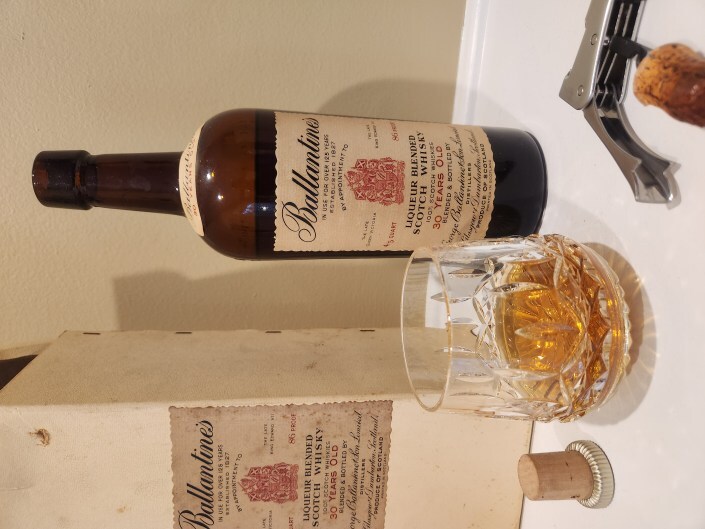
I accomplished something I never thought I would. I earned my doctorate. It’s not that I didn’t believe I could. It’s that I never thought I’d possess the time or money.
Technically, I had seven years to do it before requiring an extension. I did it in two. And I maintained a 4.0 GPA, ultimately earning a medal of high distinction and the rank of Summa Cum Laude. As you can see from the image at the end of this jaunt, I elected to display the cords and medallion in a prominent place in my basement.
For the record, I’m not bragging. Well, maybe I am a little. I suppose it is something to be proud of. Conversely, however, the epicentral point is that I maintained an educational pace I would never recommend to anyone. I lived, breathed, and slept my effort’s research and eventual 298-page paper until I finally defended all of it in committee. Along the way, I doubled and tripled up on required cognates, taking full advantage of flat-rate tuition caps only to absolutely bury my life, labors, and family beneath reading, writing papers, more reading, and more papers.
I can assure you, there’s nothing worse than listening to your wife and children frolic about in the pool as you spend most of your vacation days in a kitchen nook swimming in an ocean of reading and writing assignments.
In short, I’m glad it’s done and that the degree has been won and bestowed. Nevertheless, I would never recommend doing what I’ve done. If you have the time, take as much of it as you need. You’ll preserve your sanity’s reserves.
However, I should qualify some of my reasoning. One of the only reasons I managed as I did was because I have a writing disorder. Truly. Beneath this disorder, it’s very likely I read and comprehend at a much slower pace than most. And yet, on the other, once I’ve taken hold of a concept, I can tippity-tap a lot of content in a very short period. A paper, a sermon, a blog post—give me an hour, and I’ll give you ten pages. Will they be good pages? I don’t know. That’s for the professor, parishioners, or readers to decide.
Ultimately, to celebrate the doctoral journey’s completion, only a superb whisky would do. That said, I’d been looking for a reason to open the Ballantine’s 30-year-old edition that’s been sitting on my shelf for many years. Before I tell you about it, there are a few things to keep in mind concerning this celebratory selection.
First, as I mentioned, it’s 30 years old. Second, it is a near-perfectly preserved edition bottled in 1952, meaning it was distilled in 1922. Doing the math, this whisky was first conceived and put into a barrel 102 years before I opened it. What’s more, 1922 is two years after America’s pietistic hijacking, resulting in a nationwide prohibition on alcohol. That is an interesting aspect, too. Third, I’ve been staring at it for over a decade but never had the heart to open it. I’d need a reason that exceeded my ability to resist.
June 6, 2024—the day after a successful thesis defense—I found myself too weak to withstand the temptation. I was joyfully tired and in need of extraordinary rejuvenation. In this weakened state, rather than resisting, I found myself making every excuse to open it.
The first excuse was the occasion itself. Indeed, I deserved a delightful treat, yes? The second excuse noted I’d be 52 years old this year. A whisky bottled in 1952 seemed to be a sign. My third alibi, also a sign, was that I was celebrating my 30th year in ministry.
Three strikes and the bottle was out. Indeed, and amen, the whisky planets were in rare alignment. With that, it was opened, and a two-finger dram was poured.
Before this occurred, I had two concerns. The first was for the cork. I invert my whiskies regularly, at least once a year, hoping for moistened corks among the ones that sit a little longer than most. There’s nothing worse than a cork that crumbles and falls into the whisky when it’s opened. Thankfully, this one gave way with very little fuss. It left behind some residue in the bottle’s mouth, but it was easily wiped clean.
The next concern was for the whisky itself. Before I bought it in 2012, I was assured it had been stored properly. When I received it, indeed, it was well kept. But I could see it had experienced some evaporation. Not much. Still, even a little can alter the whisky entirely.
Thankfully, all was well. The nose was a bit harsh, wafting an initial scent of vinegar. After sitting a few minutes, it became vegetal—or more precisely, it reminded me of freshly cut grain following a rainstorm. This was not horrible. It was a revelation of age.
The palate was a delightful concoction of smoked chocolate, charred cinnamon, and salted butter—an absolutely delicious combination leading to a lengthy cinnamon finish.
In conclusion, to those who wondered if I’d ever arise from higher education’s burial mound, I can confirm I have emerged. I return from the other side with an expensive piece of paper and a fantastic whisky, both being endeavors worth the wait.
————
Note: If you’re at all interested in reading my thesis, you may download it here.

The post Review – Ballantine’s, 30 Years Old, 1952 Edition, 43% appeared first on AngelsPortion.
July 16, 2024
Review – Fuyu, Blended Japanese Whisky, (No Age Stated), 40%
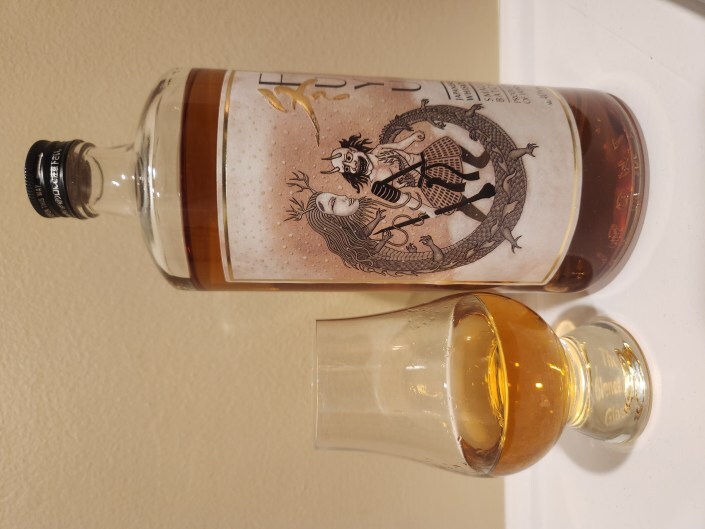
There’s never been any question about whether I’m a whisky connoisseur. I’m not. The word has been used on occasion to describe me, but it has been used mistakenly. I’m a whisky enjoyer.
I cannot tell you the histories of the various distilleries. I cannot name the Master Distillers that orchestrate them. I can barely extrapolate the whisky-making process in reasonable detail. Admittedly, I may know more than most about these things. But that’s to be expected from anyone who appreciates something enough to write about it. Still, I do not own the title “connoisseur.” Again, I’m an enjoyer.
Having said this, I’ll admit I exist in an in-between space, a whisky limbo of sorts. I’ve passed on to another place beyond the typical imbiber who might sip a dram and say, “Wow, that’s really smooth.” In fact, when I hear someone describe a particular whisky in this way, I’m reminded of the world I left behind—a world that experiences the divine but cannot describe its swirling activity. Still, there’s another world beyond this, and it’s owned by the connoisseurs, which, again, I am not. I haven’t reached their saintly tier. I remain between worlds, albeit equipped with strange senses I never knew I possessed. Until, one day, I did. (Many thanks to the London shop owner who made this possible.)
My only genuine offerings to the whisky world are a keen sense of discernment and the ability, nay, my need, to tell a story. I can parse a whisky’s peculiarities—the nose, palate, and finish—and I can do it in a way reminiscent of Raymond Babbitt counting toothpicks. However, I somehow know the story behind the toothpicks, too. I once attempted to describe what I mean in the introduction to The Angels’ Portion, Volume 3. I wrote:
The stories are never applied to the whiskies. The whiskies reveal the stories. In other words, the stories are already there. I imagine each as awaiting retrieval from a lockbox on a shelf in the storehouse of my mind. Each whisky serves as the inimitable key to its own box. In the process of sniffing, sipping, and finishing a dram, the story is fetched, and the whisky’s heart is rendered. Sometimes, the story includes Darth Vader. Another time, there may be a shark named Gary or an unfortunate brawl with Santa Claus at Walmart…. As far as I know, no one else reviews whisky this way. This makes The Angels’ Portion matchless in the field of whisky-related literature.
I’m not a connoisseur. I’m an enjoyer. And can you see why? With every new edition, there’s a new story to experience. Whether the whisky is good or bad, there’s always an enjoyable narrative lurking beneath its amber surf. Indeed, even the bad whiskies can be a treat, if only for the stories they tell.
For a snippet example, the Fuyu small batch blended Japanese whisky was less than impressive, and yet, it stirred a completely tangential thought. With a nose more like a chilled but dry Cabernet Sauvignon that died on the shelf in a dank wine cellar, and a strangely hostile palate of salt-ginger and charred soy, all culminating in a long and angry finish, I was reminded of how much I hate winter in my home state of Michigan. Michigan winters are crisply dark, thickly coated in road salt, and seemingly unending in their hostility, lasting at least three-fourths of the year. I’ve never sipped a whisky and immediately thought, “Michigan winters are the devil.” And yet, as it turns out, Fuyu means winter. Go figure.
Regardless of the whisky’s drinkability, its associative story was useful, even if only to warn: measure all property purchases in Michigan in the same way you’d consider purchasing a bottle of Fuyu. If you like winter’s perpetual sadness, go for it.
Finally, there’s something I simply cannot overlook. Say the word “fuyu” (foo-yoo) out loud. Now, imagine the following. You’re in Japan. Thirsty for an obscure but native dram, you travel to a local liquor store. You see the uniquely labeled Fuyu in a dimly lit corner. You throw down some yen. You take it back to your hotel. You sip it. Realizing your mistake, you return to the store, insisting you accidentally purchased toilet bowl cleaner and demanding a refund. The non-English-speaking proprietor laughs snarkily and replies, “Fuyu,” shooing you away from the counter.
A coincidence? I wonder.
The post Review – Fuyu, Blended Japanese Whisky, (No Age Stated), 40% appeared first on AngelsPortion.
July 15, 2024
Review – Tamnavulin, Sherry Cask Edition, (No Age Stated), 40%
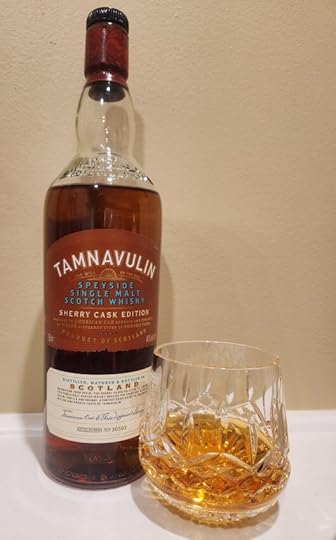
Whisky has powers that no other beverage possesses. It’s not so much that it can intoxicate, but rather, when enjoyed as it should be, it soothes, almost medicinally. For this very reason, I have a dram every night before bed.
My wife complains that bedtime is the worst time. It’s not because, as it would be for any beautiful woman, she risks advances from the man beside her when she’d much rather sleep. Instead, it’s that time when she wanders the corridors of her mind, revisiting the day’s events. As a result, she struggles to fall asleep. Not so with me. I take the last little sip of whatever whisky is on deck, and within five minutes, I am, as she describes, asleep and breathing annoyingly deeply. Stuck in her mental self-analysis, she increases the sounds of rushing water on her mobile phone and joins me forty-five minutes later.
I’ve tried for over a decade to convince her of whisky’s benefits, all along the way keeping my palate ready for one I think she might enjoy. Still, she refuses even to try, remaining apart from the ranks of bedtime serenity, preferring inanimate gymnastics instead.
And so, because a prophet is not welcome in his own hometown, I’ve been tempted on occasion to orchestrate an email campaign with my readers. The kindly folks that you are, if I were to share her email address with you, I’m sure she’d receive a tidal wash of encouragement from those who know whisky’s blessedness. From there, I anticipate one of two results. Either she’d be furious with me, thereby severely limiting the success rate of my future bedtime advances, or she’d lift her whisky embargo and give one of your recommendations a try.
Because I know her tastes well, and I know she’s not much of a self-spender, may I influence your first good-hearted recommendation? If only she’d give it a try, the less expensive but sweeter Tamnavulin Sherry Cask Edition might christen her rightly for lifting the day’s anchor and setting sail upon the dreamscapes of sleep.
With a raspberry and gingerbread nose, the ambered dram fills one’s topgallant and mainyard sails with sweeter winds born from trouble-free shores. Those shores—a palate of caramel and spicy cakes drenched in new honey fresh from the bee’s comb—beckon both sailors and passengers to quieter destinations than all days before. The arrival, its finish, is a medium-wide beachhead of scattered citrus and oak planks. At first glance, you wonder, “Are these shipwrecks?” But a few minutes ashore and you realize they’re not. The new land’s inhabitants disassembled their vessels, having chosen to stay.
I’m sure if she tried the Tamnavulin Sherry Cask Edition, she’d agree. Although, as I’ve mentioned in previous writings, if she is eventually persuaded, it’s likely her horizons will broaden. Inevitably, that means a steadier drain of my various whisky cabinets.
Hmm. I do love her. And what’s mine is hers. Still, there are other ways to help her sleep. Maybe I should just buy her some Unisom sleep tablets instead.
The post Review – Tamnavulin, Sherry Cask Edition, (No Age Stated), 40% appeared first on AngelsPortion.
April 22, 2024
The Angels’ Portion, Volume 5!
Volume 5 is out and in bookstores! Of course, Amazon or Barnes & Noble are the swiftest avenues for retrieving it.
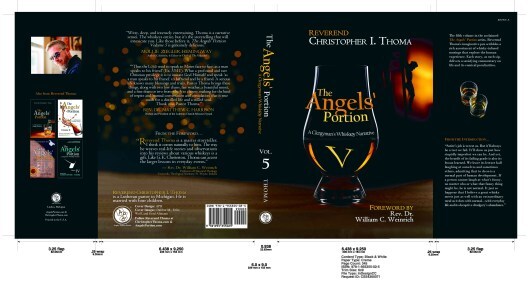
The post The Angels’ Portion, Volume 5! appeared first on AngelsPortion.
June 29, 2023
Review – Bruichladdich, Octomore 12.3, (No Age Stated), 62.1%
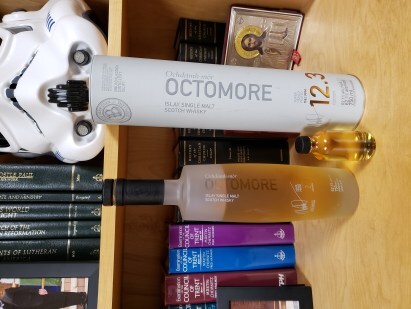
The summer’s early morning sun, as full at this moment as it will be in the late evening, is peering through my window. Its beams promise a wonderfully scorching day. There are no such promises in autumn or winter.
I’m a summer man. I need what summer brings. However, as a Michigander, I’ll admit to an occasional affair with autumn. But never winter. Winter is the devil’s business. Autumn is altogether different. Its seduction is lovely. Its whispers are rustling leaves, giggling trick-or-treaters, the first bite of an orchard’s apple, and sandhill cranes screeching from a chilled river’s shore. Its scents are the fireplace’s breath, a favorite sweater, and warmed pumpkin pie. Its sights are landscape-sized detonations of rubied and golden treetops soon made bare by downward swirls of equal hues.
To experience autumn is to learn L. M. Montgomery’s scribbled sentiment, “I’m so glad I live in a world of Octobers.”
Still, I’m a summer man. And every year, the only way for me to let summer go is to pay close attention to autumn’s deepest lesson. The trees have leaves. But they must let them go and move on. And until they do, they’ll be forever leaving summer rather than drawing closer to its promised return.
Letting go is often one of life’s necessary steps.
I have plenty of things I wish I could hold onto forever. My wife. My children. My whisky. My health. My relative self-sufficiency. My whisky. My memories. My whisky. My books. My whisky. And, I suppose, my whisky. And why wouldn’t I feel this way about these things, especially when I’ve known them all along as gifts—unmerited favors to me from God?
Nevertheless, all things have a season. I’ll let them go. But not for long. I’m not destined for this world’s recurring seasons. I’m aiming toward an eternal summer where many of these gifts will return to stay. This delightful hope most certainly includes my wife and children. And I’m pretty sure that if eternal life is as great as it sounds, whisky will return, too.
I’ve written about certain whiskies I expect to see on the Lord’s shelf. I know He’ll have a few from The Balvenie. I’m counting on a few more from The Macallan. I’m confident there will be a shelf devoted to Laphroaig. I’m convinced He’ll have a cabinet of Bruichladdich Octomores, especially the 12.3 edition. I know it likely sounds trite, but the 12.3 is very nearly heavenly. It’s a divine summer’s wonderful heat in a bottle, joyfully pleasant in every way. But it’s also a dram that leans into autumn’s glory.
The 12.3’s nose recalls an orchard’s ripest apples smoked with freshly fallen oak leaves. Its malt remembers open fields at harvest time. A sip’s savoring looks back to summer with fondness. It stirs up comfortable memories with family—of feasting on seasoned meats and buttery breads before taking an early evening seaside stroll drenched in salty breezes.
The finish recommits to autumn’s innermost lesson. Its dried fruits, honey, and smoke linger long enough to enjoy while also being thoughtful enough to remind, “The sooner you let me go, the sooner you can poor another, and I can start again.”
And so, you let go—as it is and must be with so many of life’s delightful things.
The post Review – Bruichladdich, Octomore 12.3, (No Age Stated), 62.1% appeared first on AngelsPortion.
June 28, 2023
Review – Matsui Whisky, Tottori, Blended Japanese Whisky, (No Age Stated), 43%
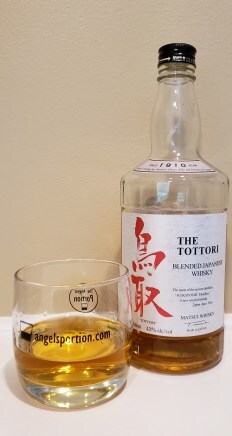
I’ve often thought that if I were to force an exchange of my children’s video gaming with another viewing interest, I’d steer them toward nature shows. By comparison, a documentary detailing life’s varied wonders seems an easy choice compared to the carnage inherent to “Call of Duty.”
But there’s a problem with this assumption. Stop by the Discovery Channel. Pick any nature show you’d like. Watch its episodes. Pick another show. Do the same. You’ll uncover something rather interesting. Nature shows are little more than everything murdering everything else. Carnivore or herbivore, every living creature has an inclination, and often a well-honed skill, for mauling and killing friend and foe alike. Sometimes they have a reason. Other times, they don’t. Nearly all, even the seemingly cutest, has brutal hierarchies that reward the cruel and banish the weak.
A viewer will be treated to great white sharks hunting cute, cuddly, chillaxing seals. As a shark lurks, concern for the seemingly helpless seals stirs an audible, “Oh, no! Swim away, little guys!” A few minutes later, the viewer is treated to the seals beating each other nearly to death with their own heads as they vie for community lordship. And the loser, well, he’s sent away to die from his internal injuries.
Choose a different show, one about zebras. Ah, zebras. Wouldn’t it be neat to experience a herd of exotically beautiful zebras? Sure. Until you realize they have no problem kicking out each other’s jaw bones and stomping each other to death. Far more zebras die from other zebras than they do from predation.
Wendell Berry, an environmental activist, once said something about resting in the grace of nature. I’m guessing that Berry has never lathered up in sunscreen and enjoyed an unguarded day on the Serengeti Plains, one trusting fully in the hyena’s graces. I’m guessing he’s never taken a frolicking dip among the great whites circling Seal Island in South Africa.
You’re better off playing with matches beside a leaky can of gasoline than trusting nature to be gracious. I’m telling you, even the fluffiest things are looking for a way to kill you. At some point, I fully expect The Discovery Channel to produce a nature show about bomb-making sloths or geckos who’ve mastered human trafficking. These awful activities may not be happening quite yet. Still, give them time. The animal kingdom continues to prove itself more than capable.
Of course, there could be a flip side to nature’s dreadful creativity. As the birds are choreographing dance moves and building personal nightclubs for all the local ladies, there may likely be a few in the bird community wondering how to stock these makeshift clubs with beverages. Subsequently, they might not be that far from making booze. And if such a thing were to occur, I’m betting on the coastal birds living in the Tottori prefecture of Japan. Japan continues to prove itself innovative in all things, most especially with whisky-making. Now, if only a singular rock pigeon, or a pygmy woodpecker, could inspire the animal realm. If only one might flitter into Matsui’s Kurayoshi distillery for an encounter with the Tottori blend. I’m hopeful that nature would, as they say, find a way.
An extremely low-cost dram, the Tottori’s nose fans herb-sprinkled apricots on a seaside breeze, implying a slightly higher place on the connoisseur’s shelf. While somewhat bitter at first, the first sip softens, bringing ruby licorice, an echo of malt, and the nose’s apricots. The finish is short, offering a mild spice before stealing it right back.
While the Tottori edition seems a relatively simple concoction, it remains uniquely pleasant. I can only imagine what might happen if the queens from two warring ant colonies were sipping Tottori while discussing their terms.
Honestly, we all know what would happen. Another sinister creature would ambush and murder the queens during negotiations. Whisky or no whisky, that’s how nature works. And so, forget everything I said about the flipside of nature’s dreadful creativity. Pour yourself a two-fingered dram of Tottori, turn on The Discovery Channel, and see for yourself.
The post Review – Matsui Whisky, Tottori, Blended Japanese Whisky, (No Age Stated), 43% appeared first on AngelsPortion.
June 27, 2023
Review – Rabbit Hole, Heigold, Kentucky Straight Bourbon, 3 Years Old, 47.5%
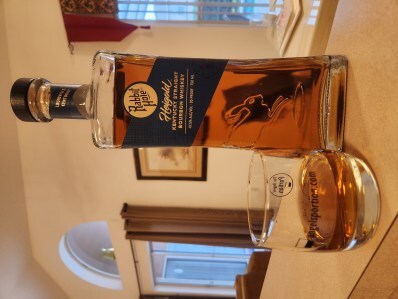
One of my daughters asked if I’d ever want to teach at one of my synod’s seminaries. I thought about it for a moment before finally admitting my willingness. I’d do it, but only if allowed to teach homiletics—the art of writing and delivering a sermon. I think my denomination is sometimes weak in this department. Indeed, our pulpits are brimming with sound doctrine. This is essential. Still, far too many listeners struggle to believe their preachers’ sincerity. They have a great handle on the formulas. They can, as Rev. Dr. David Scaer once mused, “tell the people off for five minutes, and then tell them how it’s going to be okay for another five.” More to my point, I get the sense our seminary fledglings are learning to tell people about Jesus rather than introducing them to someone they’ve met and wholeheartedly trust for themselves.
I could be wrong. I probably am. Either way, a cardinal rule for my class would be one I’ve heralded for decades. It is, quite simply, “Don’t be weird.” It’s likely I would restate this rule at the beginning of every session. I’d remind the students that if the way they’re speaking from the pulpit would sound far too weird in normal conversation, don’t do it—unless, of course, they’re deliberately demonstrating weirdness. Otherwise, don’t do it. Be a normal human being. If your congregation wanted an overly dramatic, faux-pausing William Shatner, they could’ve stayed home and watched Star Trek.
If, after a few sessions, the seminary administration decided to move me from homiletics to pastoral care, my principal rule would not change. The first words from my mouth at each session would be, “Don’t be weird.” And each time I said it, I’d share an example of what not to do when caring for parishioners. My first lesson’s introduction:
“Don’t be weird. Do not stand while urinating when visiting the facilities during a home visit. Sit. No one wants to hear his or her pastor’s burbling stream. Don’t be weird.”
Or perhaps it might be:
“Don’t be weird. I know beards are wonderful. As you can see, I have one. But if yours reaches your belt buckle, trim it—at least to mid-chest. If the parishioner wanted a visit from ZZ Top, it’s likely they wouldn’t have joined your church. Don’t be weird.”
Or another might be:
“Don’t be weird. When greeting people after worship, try to do more than a bow with your hands in a prayerfully tented position while saying, ‘The Lord be with you.’ If the people wanted to visit with an animatronic character, they could’ve skipped out to Chuck E. Cheese or visited the Hall of Presidents at Magic Kingdom. Interact with your people. Give the men a firm handshake. Hug the old ladies who want one. Reach down to the children for the same. Don’t be weird.”
Again, if, after a few sessions in pastoral care, the administration thought I might be better suited for liturgics, I’d carry my rule with me.
“Don’t be weird,” I’d say. “Do not chant the liturgy if you cannot carry a tune. Speak it. No one came to church to hear someone torturing kittens. If anyone did come to church for such things, you likely have a serial killer in your congregation. In the meantime, refrain from serially killing the liturgy. In the same fashion, do not sing the liturgy as though you’re recording a hit single or auditioning for “America’s Got Talent.” The odds are pretty good that Simon Cowell won’t be in your pews. Either chant the liturgy accordingly or speak it. Do not maul it, and do not perform it. Don’t be weird.”
If, after a few sessions, the seminary administration decides I’m not a good fit for teaching any of their disciplines, all would be well. I’d be right back where my chief rule, measured against all things, pays the greatest dividends: real people in a real congregation.
Looking back at the words I’ve just written, I’m reminded of my and my family’s time yesterday on vacation visiting with some friends. A bottle of Rabbit Hole’s Heigold edition uncorked, these friends asked an intriguing question. Fully aware that the Thoma family avoids as much contact with other humans as possible while on vacation, how is it that these friends were included in their restful time? How is it that the Thoma family was even willing to drive two and a half hours to see them?
Firstly, because they are as I’ve described them—friends—the kind you knew would be good friends within minutes, not days. They’re the kind who mirror one’s self in far too many ways to be accidental. Secondly, in the middle of all life’s disconnecting weirdness, God sprinkled some connective normalcy. They’re proof. He brought along people who, as Cicero described, are truly capable of doubling each other’s joys while dividing the misery. And if that weren’t enough, they’re not true weirdos, as in, they aren’t pietists. They’re a clergy family at home in their own sphere with a pleasant dram and easy conversation.
As I mentioned, the Heigold edition was a part of the pleasantries exchanged during the visit. They cared for us with a well-adorned charcuterie and their time. I brought the whiskey. I’m glad I did. It was more than suitable for such a refreshingly weird-less moment.
With a strict nose of cinnamon and buttered toast, the Heigold cradles the moment’s friendliness. It doesn’t intrude. Instead, it hovers like a watchful servant ready to make its master’s time with friends enjoyable. And it succeeds.
A sip reveals its attentiveness, occasionally stepping forward to whisper singed cloves and sugar, dry oak, and peppered rye into the conversation. A share of water amplifies its kindly vocabulary, carrying the pepper back toward the nose’s cinnamon.
The finish is a longer swath of spicy caramel. Its prompts, “Please stay and enjoy another.” And you’re inclined to do so. Why? At first, it might seem right to stay because you’re on vacation. When vacationing, time often has little meaning. And yet, you’re with friends who aren’t vacationing, and even among friends, overstaying is weird. Remember, don’t be weird.
Nevertheless, you relent to the whiskey’s prompt. And why? Because in this circumstance, you’re inclined to preserve your vacation formula. Vacationing means resting with one’s beloved—with family. An overstay is not weird with family, and right now, that’s who you’re with.
With that, you pour one more and continue in conversation, knowing the time is not weird but divine—a gift—and you intend to rest in it.
The post Review – Rabbit Hole, Heigold, Kentucky Straight Bourbon, 3 Years Old, 47.5% appeared first on AngelsPortion.
June 26, 2023
Review – New Riff, Kentucky Straight Bourbon, 4 Years Old, 50%

The poet William Stafford once mused that children bear skillful qualities unavailable to adults. Specifically, he wrote that children “dance before they learn there is anything that isn’t music.” Observing my own children, I know he’s right. No matter the circumstance, good or bad, they’ll hear a moment’s musical accompaniment resonating from unhearable spaces. And then they’ll dance to it. Sometimes those spaces will send lyrics.
Again, fortune or tragedy, a danceable song will emerge. Strangely, my children seem more attuned to tragedy’s repertoire. In other words, while on vacation, their father’s face could get stingingly struck by a rubber ball in the swimming pool, and suddenly, a motion-filled song and dance begin. The song has ten glorious verses. Moreover, the musical interlude’s inspiration is so fantastical that onlookers desire a part, asking the victim, “Can I hit you in the face with the ball, too?! Go to the other end of the pool, and we’ll all take turns! See if you can do it without flinching!”
Never mind that Dad’s wound needs burn cream. The “Loser” song and its subsequent efforts are bringing incredible joy. As my wife so often says, “Parenting requires impenetrable self-esteem.”
Fortunately (or unfortunately) for my children, their father has retained much of his child-like self while also enjoying a high threshold for pain. With that, he’s more than happy to oblige their darkly performances—so long as he can volley its joy. This means he’s glad to accommodate their uncoordinated throws, responding to them with a more rocketing accuracy, leaving their soft, weatherless faces far redder than before.
Interestingly, it’s then that the “Loser” song is suddenly less danceable. It becomes dirge-like, strumming an entirely new riff, the kind that requires a soothing alternative. Sorry, kids. Only the adults get to dance to God’s better tunes. While you nurse your wounds with a juice box, I’ll groove to a New Riff Kentucky Straight Bourbon dram. I’ll be ready for more a few minutes later, having become even sturdier against your assaults.
Admittedly, like a rubber ball, the New Riff stings the nose a little at first. But it’s a coaxing sting, one stirring the imbiber to respond, “Bring it on.” Embracing its gruffness, herbal scents emerge. Another sniff rewards the resolve with honeyed citrus.
The palate reverberates similarly, plucking spicy vanilla strings on oaky frets. A little water causes a chord change. What was spicy becomes slightly sweeter, offering a swifter cinnamon and raspberry jam tempo. The medium finish scribbles similar notations.
The New Riff is an enjoyable ditty. If it were a song, you’d be inclined to play it on repeat. It’s certainly capable of providing a post-rubber-ball-war orchestration worthy of smiles. Well, smiles from Dad, at least.
The post Review – New Riff, Kentucky Straight Bourbon, 4 Years Old, 50% appeared first on AngelsPortion.



